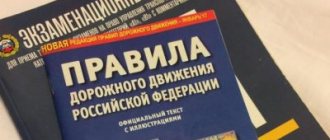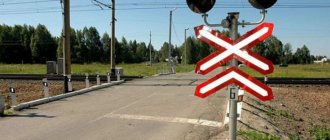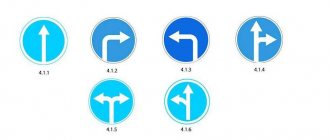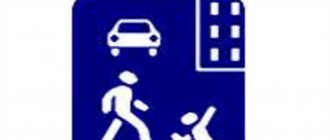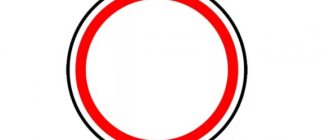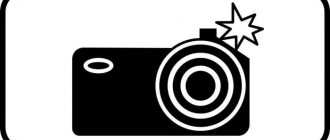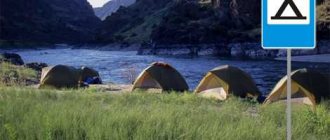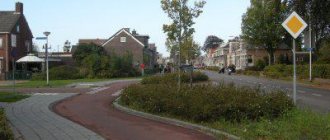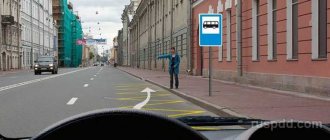Sign 6.5., which few people know about. Is it in the traffic rules and what does it mean?
Surely many have seen this sign on the roads, some did not pay attention to it because there was no need, and others simply glanced with interest.
Every day there are more and more road signs; it is possible to remember them, but not always. This is especially true for those who passed their license a long time ago and threw the book with traffic rules on the top shelf in the closet. Here, many people should take note to glance, at least briefly, at the set of traffic rules. If you thought that this sign did not exist before and was introduced quite recently, then you are deeply mistaken. Sign 6.5 has been present in traffic regulations for a very long time, but it is unrealistic to see it on traffic tickets.
There is a similarity with sign 6.8.1 (dead end), but it is not at all great, only in visual terms. Despite the indexical proximity, the designation of the sign is completely different. What did you think when you first saw the sign? What does he look like? Everything is quite simple here, perhaps you didn’t know anything about it because you didn’t care about it.
So, sign 6.5 is nothing more than a regular blue plate with two stripes visible on it. White graphic stripes indicate the road. Also pay attention to the red squares that are located on the white lines; by the way, they are arranged in a checkerboard pattern. This is not a dead end, don’t be confused. It is usually installed near long slopes. Its name is “emergency stop strip”. Drivers of passenger vehicles will not need such a sign, but if you drive a truck or large-sized truck, then read on.
The sign indicates that there is a special lane nearby that is intended for freight transport. It was invented specifically for large and heavy cars. Why for them? And there is an explanation: the fact is that it is precisely this kind of transport that most often encounters overheating of the brake pads, and this can lead to dangerous situations on the roads. In order to avoid this, it is better for heavy vehicles to drive in a special lane.
Agree that a steep descent carries great danger. If a driver moves at high speed, this can lead to various outcomes, including an accident. Such an emergency stop lane allows you to enter it and stop without an accident. After all, it is not recommended to use the braking system in such extreme situations. The driver, seeing such a sign, will know that there is a special section of the road here.
If the road is very steep, then along with the “6.5” sign an additional sign 8.1.1 (distance to the object) is installed, as well as the sign itself, which indicates a steep descent of 1.13. Traffic regulations allow the repeated use of signs along a certain section of the road. Thus, the driver, even if he looked at the first sign, will definitely see the second one.
If this information is useful to you, write about it in the comments. Perhaps you once came across an interesting story related to this sign.
Road signs | Traffic regulations online
Appendix 1. Road signs : 1. Warning signs 2. Priority signs 3. Prohibition signs 4. Mandatory signs 5. Special requirements signs 6. Information signs 7. Service signs 8. Additional information signs (plates)
Select the desired section of road signs.
Road signs are a special song. Along with road markings, traffic lights and traffic controllers, signs are a powerful means of regulating traffic.
However, signs are also the most universal way of regulation. What causes this? If you please.
- Road signs are very clear. The symbolism used in them is extremely simple and understandable. In other words, what is drawn on the sign is what it means. And, in principle, even without knowing the signs, you can guess their meaning.
- Road signs are a fairly economical means of regulating traffic. Unlike markings, traffic lights (very expensive from a financial point of view) and traffic controllers (who, in general, need to pay a salary), road signs are a cheaper option. As they say, cheap and cheerful.
- Signs are an “eternal” way of regulation. Road markings either quickly become unusable or become covered with snow in winter. The operation of traffic lights at night is simply impractical, and the traffic controller is a biological type with normal natural capabilities and needs. And only a road sign can realize its functions at any time of the day, at any time of the year and in any weather.
That is why road signs are considered the “alpha and omega” of the Rules of the Road. Despite their large number and difficulties in studying and analyzing, knowledge of the principles of operation of road signs will allow you to navigate well in traffic practice. And this, you see, is worth a lot...
Traffic regulations online from autoass.ru.
The content of the article:
- road signs
autoass.ru
According to GOST
In a snowstorm (and even in the dark!), the driver, as a rule, makes a lot of effort to understand which sign the bad weather is hiding from him, and whether he has accidentally crossed a solid marking line. It is much easier to avoid unpleasant situations when the road is well known. But what if you find yourself somewhere for the first time? Therefore, when a car is suddenly stopped by a traffic police officer, many are surprised and at a loss, not knowing what exactly they violated and where to start the dialogue. But, as you know, the best way to defend your case in a conversation with an inspector is to turn to the law.
In paragraphs 4.3, 4.4, 5.1.4 “GOST R 52289–2004. Technical means of organizing traffic" says:
“Signs and traffic lights (symbols - according to Table A.1 of Appendix A) are placed in such a way that they are perceived only by the traffic participants for whom they are intended, and are not obscured by any obstacles (advertising, green spaces, outdoor lighting poles and etc.), ensured ease of use and reduced the likelihood of damage... On sections of roads where the markings defining the traffic mode are difficult to distinguish (snow, mud, etc.) or cannot be restored in a timely manner, signs corresponding to their meaning are installed … The visibility distance of the sign must be at least 100 m.”
see also
Comments 109
I support the author: “share information with others - don’t let these freaks make money.”
For simplicity, let's not consider “hammers”. Let’s just note that not only in Moscow (I won’t say for the whole of Russia) but also in some large cities of the Moscow Region, dedicated lanes marked with sign 5.14 were also equipped with a “brick” 3.1 hanging above this lane, with a “down arrow” sign. This created confusion among taxi drivers: are we allowed or not? Those who dared to check received a 500 ruble fine from the cameras for each case. TsAFAP inspectors explained that, by virtue of 3.1, these lanes are only suitable for route public transport, i.e. buses and trolleybuses, but taxis are not allowed, because although they are public, they are not route buses. Yes, that's right, not a route one. What do you think, if 3.1 hung without 5.14, what would that mean? This would mean exactly this: only route vehicles are allowed to move. But 3.1+5.14 is nonsense, two contradictory signs, and the traffic rules do not provide for this. Only the contradiction between a temporary sign and a permanent one is provided for—here priority goes to the temporary. The unfortunate combination 3.1 + 5.14, when both signs are constant: one allows the movement of someone else (in particular, taxis), except for trolleybuses, and the other prohibits it - this is stupidity and misleading the driver. Driving a taxi on a dedicated lane in this situation does not constitute an offense! Find in the traffic rules the text that the brick is most important. It's not there. I urge all taxi drivers who have suffered from this nonsense to complain to the Moscow prosecutor’s office about the actions of the Data Center and TsAFAP, to demand the cancellation of all decisions received, and the return of fines paid, if they have already been paid.
Read also: Wiring diagram for power windows of VAZ 2114
Is there a flaw in my arguments? Be that as it may, from the end of December 2015, the data processing center began removing bricks from all allocated areas in Moscow, and from January 2021 they were gone. Even electronic billboards appeared: “All legal taxis can move on all designated lanes in Moscow.”
Well, to hell with them and their allocated funds... I didn’t go anywhere and I don’t go... because I’m tired of replenishing the budget. On Leningradskaya in one place they hung some signs regarding the allocated area, and after 200 meters there are others hanging...
As for foreigners, I don’t see any problems. I was going to Finland by car, reading notes about their rules. They also have signs with the days of the week. Learned it. If I didn’t learn it, I wrote it down. If you don’t write it down, you’ll be fined once, then you’ll learn it right away. And with these dedicated cameras, I try to never go into them, just in case, otherwise the date or time on the camera will go wrong and then go prove that the shadow from the car is from the sun on the Sun, and not from the full moon on Mon. Well, if I have to stop by, I always make sure that the hammers are hanging.
Until now, speaking about additional information signs (or plates), we have noted the restrictions or additions they introduce, which relate to the distance, direction of action or type of vehicle.
In other words, the signs installed with these plates were effective on a certain section of the road, which was characterized by these three signs.
However, the Rules provide for a large group of signs that limit the effect of the signs installed with them according to a different criterion - time.
It is not at all difficult to guess that these signs indicate a certain period of time - either certain days of the week, or some chronological period. And a sign installed with one of these signs will only be valid for the specified period of time.
Read also: Problems in hinge joints
Let's look at the first sign - with a “red snowflake”. It is called "Saturdays, Sundays and holidays" (8.5.1). A “Red Snowflake” sign installed with any sign means that this sign will “work” only on weekends (Saturday, Sunday) and holidays. And never again.
Judging by the image, entry to this section of the road will be prohibited only on Saturdays, Sundays or public holidays (i.e. holidays prescribed in the Labor Code of the Russian Federation). On other days of the week (of which, by the way, there are much more), the ban on entry to the specified section of the road from this direction does not apply.
Or here's another example.
The combination of the sign we are interested in and the “Parking (parking space)” sign (6.4) means that parking on this section of the road will be allowed only on weekends and holidays. On weekdays, parking here is not allowed.
Thus, sign 8.5.1 “Saturdays, Sundays and holidays” (“red snowflake”) informs drivers that the effect of the sign installed with it will only apply to a specific period of time - on non-working days of the week.
If this information was useful to you, please write about it in the comments. If you have any questions, write, I will definitely try to help you.
Signs working days, holidays, type of vehicle
Good afternoon, dear reader.
The next article in the “Traffic Signs” series will look at several new additional information signs. Let me remind you that these signs are special plates that are installed together with road signs of other groups and are intended to clarify their characteristics.
Today we will look at the following signs:
- direction of action;
— type of vehicle;
- Saturdays, Sundays, holidays;
- work days;
- days of the week.
Direction sign
Direction road signs indicate in which direction the sign above the sign is valid:
Direction signs, according to GOST, can be installed together with the following road signs:
For example, on the road you may encounter the following combination:
It means that motorcycles are prohibited on the road being crossed (in both directions).
In addition to the above signs, plates 8.3.1 and 8.3.2 can be used in the following form:
In combination with the parking area sign, these signs indicate that there is a parking area to the side of the road. In this case, the site itself should be no more than 10 meters from the edge of the roadway.
Vehicle type sign
Road signs “Type of vehicle” indicate the group of vehicles covered by the road sign installed above the plate:
— trucks with a permissible maximum weight of more than 3.5 tons (including with a trailer).
- trucks and tractors with a trailer or semi-trailer, as well as vehicles towing motor vehicles.
Perhaps this sign needs to be examined in more detail, because... its meaning is not entirely clear. It does not apply to passenger vehicles with a trailer, but does apply to passenger vehicles towing. I recommend remembering this moment.
— passenger cars, as well as trucks with a permissible maximum weight of up to 3,500 kg. This plate applies exclusively to vehicles of category B.
Next, I would like to draw your attention to the fact that the meanings of the following four “type of vehicle” signs are not deciphered either in the text of the traffic rules or in the text of GOST:
We can only guess that the first plate refers to buses, the second - to tractors (and possibly self-propelled vehicles), the third - to motorcycles (and possibly to mopeds), the fourth - to bicycles (and possibly to mopeds) . In general, this is another ambiguity of traffic rules. If you wish, you can interpret the signs in any way you like, but in case of violation, you may well have to defend your opinion in court.
— vehicles with “Dangerous Goods” signs.
Please note that we are not talking about cars that are transporting something dangerous, but about cars with “Dangerous Goods” signs. For example, an empty vehicle with a dangerous goods sign must comply with the requirements of that road sign.
Example:
In this case, cars and trucks with a permissible maximum weight of less than 3,500 kg must travel no faster than 50 km/h.
And this combination of signs prohibits stopping vehicles that have “Dangerous Goods” identification plates installed.
Days of the week signs
The last three signs that will be discussed today indicate specific days of the week when the road sign installed above them is in effect:
- Saturdays, Sundays and holidays. In simple terms, this sign can be called “non-working days”. Those. it operates only when the population working a 5-day work week rests.
- work days. The sign is the opposite of the previous sign.
- days of the week. The sign indicates specific days of the week when drivers must heed the sign posted above it.
For example:
A similar combination was installed near one of the markets in the city of Ryazan, where pedestrians may appear on the roadway on weekends. However, on weekdays on this section of the road you can drive at a speed of 60 km/h.
The next article in the series will look at a few more signs of additional information.
Good luck on the roads!
pddmaster.ru

